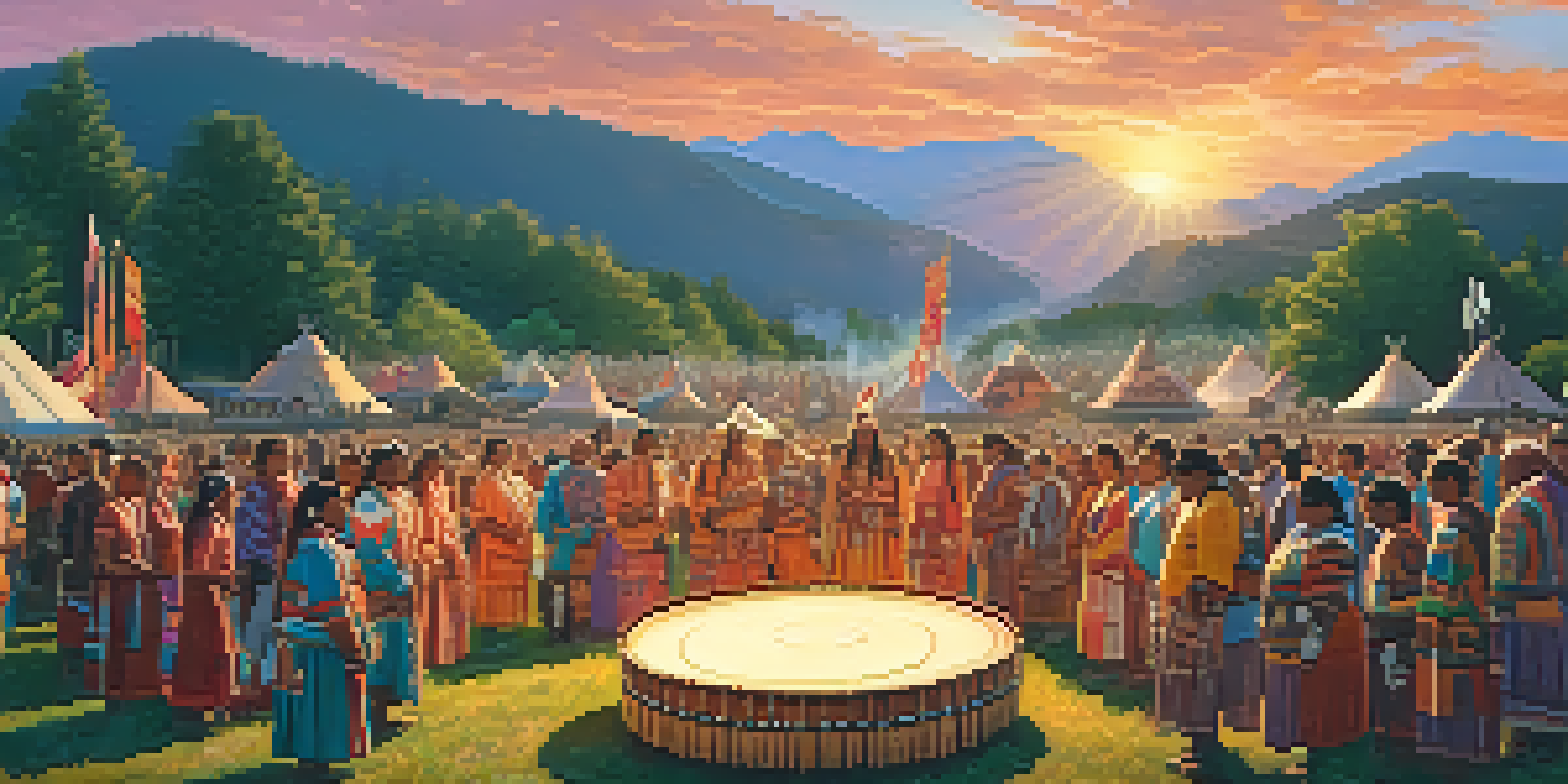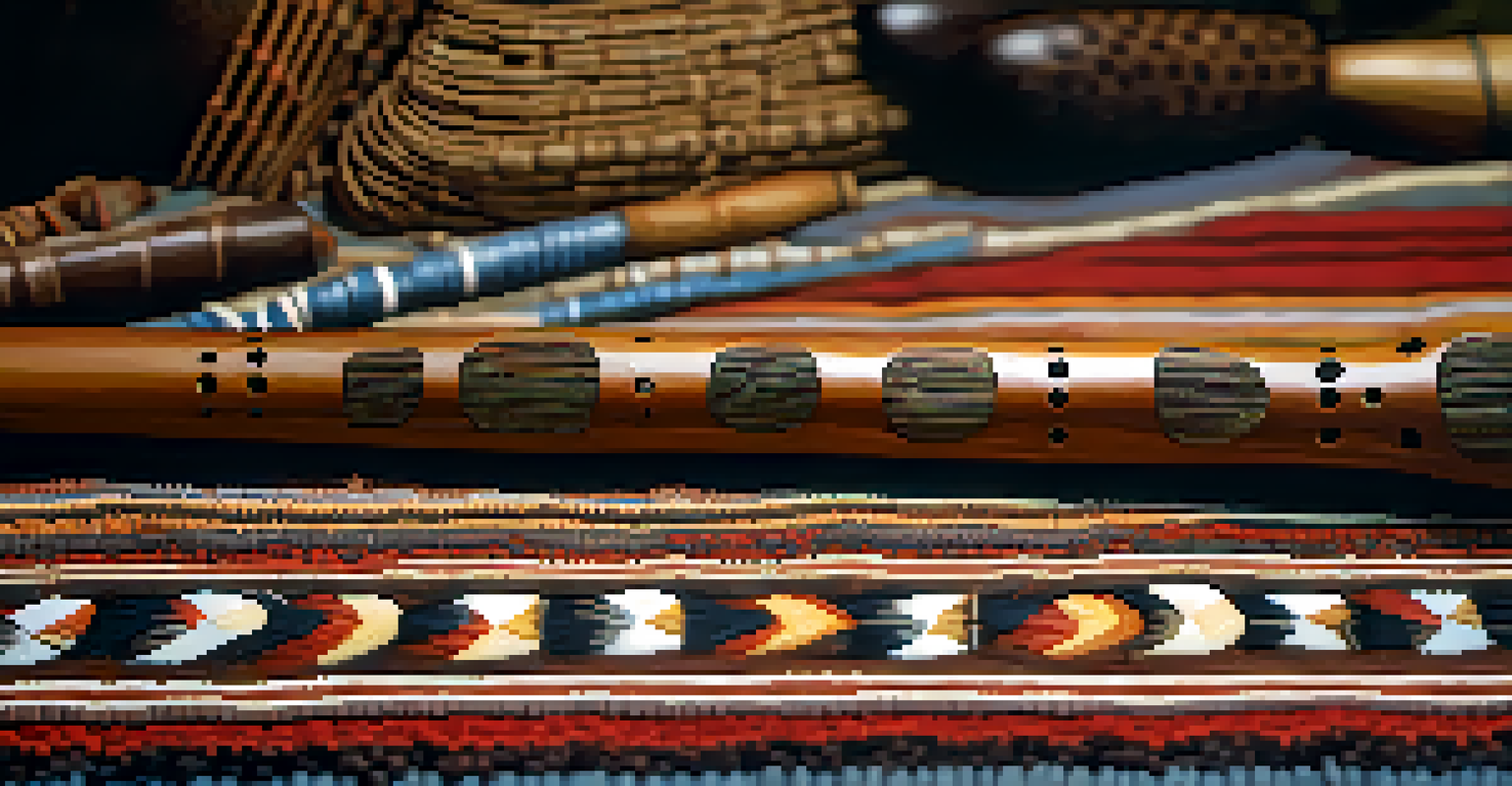Indigenous Music: Preserving Identity Through Cultural Expression

The Role of Music in Indigenous Cultures
Music has been a cornerstone of Indigenous cultures for centuries, serving both as a form of expression and a means of communication. It weaves stories, histories, and traditions into a fabric that unites communities. Through songs and rhythms, Indigenous peoples convey their beliefs, values, and experiences, ensuring that cultural narratives are passed down through generations.
Music is the shorthand of emotion.
For many Indigenous communities, music is not just an art form; it is a living archive of their identity. Each note and lyric holds significance, often connected to their land, spirituality, and communal life. By participating in music-making, individuals reaffirm their connection to their heritage, fostering a sense of belonging and pride.
Moreover, music acts as a powerful tool for activism within Indigenous communities, helping to raise awareness about social issues and cultural preservation. The beats of drums and the melodies of flutes echo the struggles and triumphs of Indigenous peoples, reminding both the performers and the audience of their resilient identity.
Traditional Instruments and Their Significance
Traditional Indigenous music often features unique instruments that play a vital role in cultural expression. Instruments like the didgeridoo, powwow drums, and flutes are not merely tools for creating sound; they embody the spirit and stories of the people. Each instrument carries its own significance and is often made from natural materials, reflecting a deep connection to the environment.

These instruments are more than just musical devices; they also serve ceremonial purposes, marking important life events such as births, marriages, and seasonal changes. For instance, the powwow drum is central to celebrations, symbolizing unity and community spirit. When played, these instruments resonate with the heartbeat of the earth, creating a profound sense of place and identity.
Music as Cultural Identity
Indigenous music serves as a living archive that connects individuals to their heritage, beliefs, and communal life.
Learning to play these instruments is often a rite of passage for young members of Indigenous communities. It fosters skills, discipline, and a deeper understanding of their cultural heritage, ensuring that these musical traditions are preserved and celebrated for future generations.
Storytelling Through Song
One of the most beautiful aspects of Indigenous music is its role in storytelling. Songs often recount historical events, myths, and personal experiences, weaving them into the cultural fabric of the community. This method of storytelling not only entertains but also educates listeners about their heritage and values.
The power of music is such that it can bring people together, heal wounds, and create a sense of belonging.
For example, many Indigenous songs feature allegories that convey moral lessons or cautionary tales, making them relevant across generations. When a song is sung, it opens up a dialogue between the past and the present, allowing listeners to reflect on their identity and place within their culture. It’s a reminder of where they come from and the lessons learned along the way.
Through storytelling in music, Indigenous peoples can preserve their languages, as many songs are composed in native tongues. This practice not only keeps the language alive but also strengthens the community's bond to their culture, as each song becomes a vessel carrying their stories into the future.
The Impact of Modernization on Indigenous Music
As the world becomes increasingly modernized, Indigenous music faces both challenges and opportunities. While globalization can dilute traditional practices, it also allows for the fusion of styles, creating new genres that resonate with younger generations. This blending of old and new can lead to a revitalization of interest in Indigenous music.
However, the risk of cultural appropriation is a pressing concern. Many Indigenous artists find themselves navigating a complex landscape where their music is borrowed without proper credit or respect for its origins. This underscores the importance of supporting Indigenous musicians and advocating for the recognition of their contributions to the broader music landscape.
Storytelling Through Song
Songs recount historical events and moral lessons, preserving language and cultural narratives for future generations.
By embracing modern technology, Indigenous musicians can reach wider audiences, sharing their cultural narratives on global platforms. This visibility not only helps preserve their music but also fosters appreciation and understanding of their cultures, bridging gaps between Indigenous and non-Indigenous communities.
Indigenous Music and Community Healing
Indigenous music holds a significant place in community healing practices. Many communities utilize music as a therapeutic tool, helping individuals process trauma and loss. The act of coming together to sing and dance creates a supportive environment where healing can occur, reinforcing social bonds and collective resilience.
In many cases, music is used in ceremonies that promote wellness and spiritual connection. For instance, songs sung during healing ceremonies can invoke a sense of peace and unity, reminding participants of their shared experiences and histories. This communal aspect of music provides comfort and strength, allowing individuals to feel less isolated in their struggles.
Furthermore, the resurgence of traditional music in healing practices is a form of reclaiming cultural identity. As communities embrace their musical heritage, they also reaffirm their strength and resilience, showcasing the power of music as a source of hope and renewal.
Contemporary Indigenous Musicians Shaping the Scene
Today, many contemporary Indigenous musicians are making waves in the music industry, blending traditional sounds with modern influences. Artists like Buffy Sainte-Marie and A Tribe Called Red are not only celebrated for their musical talents but also for their commitment to social justice and cultural awareness. They use their platforms to amplify Indigenous voices and raise awareness about important issues facing their communities.
These musicians often draw from their cultural heritage while incorporating elements of hip-hop, rock, and electronic music, creating a fresh sound that resonates with diverse audiences. This fusion allows them to reach younger generations, sparking interest in Indigenous culture and music while keeping traditional elements alive.
Modern Challenges and Opportunities
While modernization poses risks like cultural appropriation, it also enables Indigenous musicians to reach wider audiences and revitalize interest in their music.
The success of these artists highlights the importance of representation in the music industry. By showcasing their stories and experiences, they challenge stereotypes and encourage a greater understanding of Indigenous cultures, paving the way for future generations of Indigenous musicians.
Preserving Indigenous Music for Future Generations
As we look to the future, preserving Indigenous music becomes paramount for maintaining cultural identity. Initiatives focused on archiving traditional songs and practices play a crucial role in ensuring that these rich musical traditions are not lost to time. Community workshops, music camps, and educational programs can help pass on knowledge to younger generations, fostering a sense of pride in their heritage.
Technology also plays a vital role in preservation efforts. Digital platforms offer new ways to archive, share, and promote Indigenous music, making it accessible to a global audience. By utilizing these tools, Indigenous musicians can create a lasting legacy that honors their past while embracing the future.

Ultimately, the preservation of Indigenous music is a collective responsibility. By supporting Indigenous artists and their initiatives, we can play a part in ensuring that these vibrant cultural expressions continue to thrive, enriching our shared human experience for generations to come.